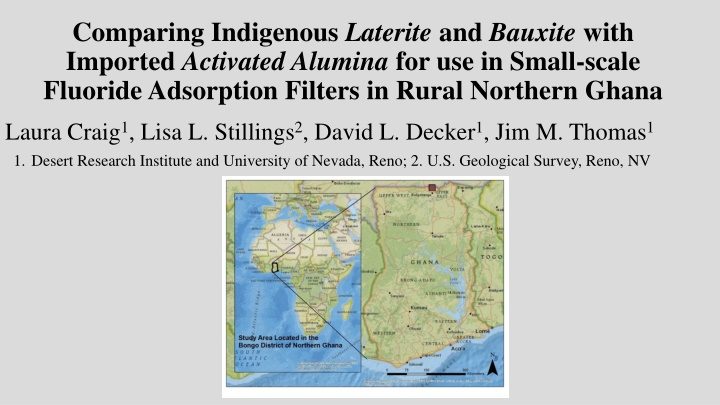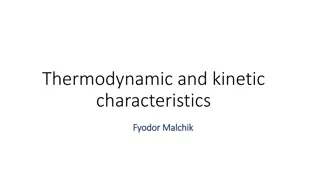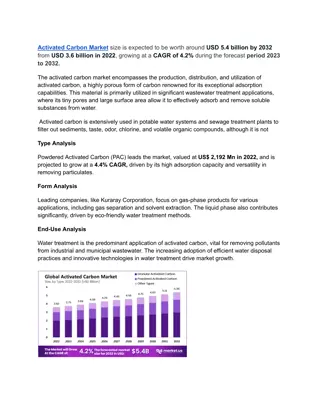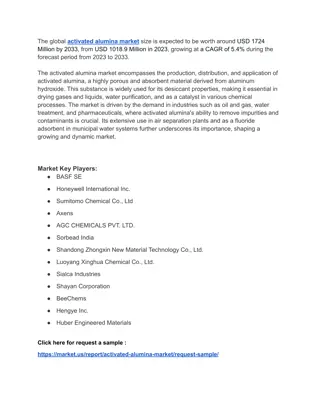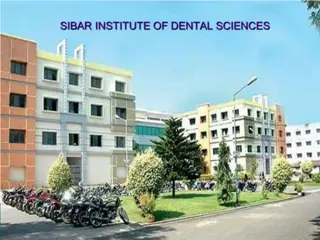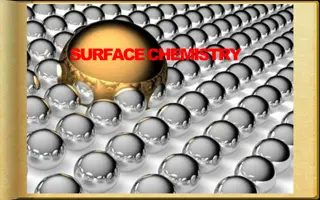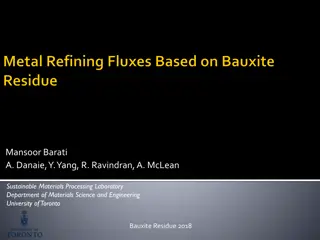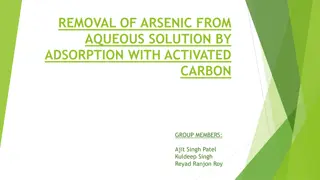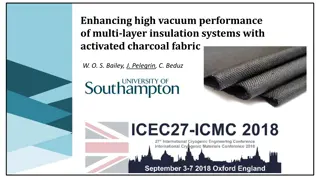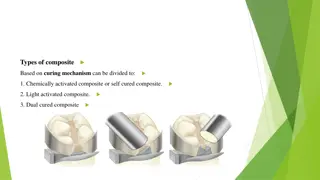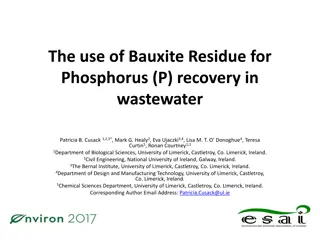Comparing Indigenous Laterite and Bauxite with Imported Activated Alumina for Fluoride Adsorption in Rural Northern Ghana
This study compares the effectiveness of indigenous laterite and bauxite with imported activated alumina for use in small-scale fluoride adsorption filters in rural Northern Ghana. It discusses the study area, the issue of fluorosis, and potential solutions using different sorbents. Physical and chemical properties affecting fluoride adsorption are analyzed, along with ways to enhance the capacity of Ghanaian laterite and bauxite. The presentation outlines the pros and cons of each sorbent for de-fluoridation filters in Ghana, leading to conclusions about their suitability for addressing the fluoride contamination problem in the region.
Download Presentation

Please find below an Image/Link to download the presentation.
The content on the website is provided AS IS for your information and personal use only. It may not be sold, licensed, or shared on other websites without obtaining consent from the author.If you encounter any issues during the download, it is possible that the publisher has removed the file from their server.
You are allowed to download the files provided on this website for personal or commercial use, subject to the condition that they are used lawfully. All files are the property of their respective owners.
The content on the website is provided AS IS for your information and personal use only. It may not be sold, licensed, or shared on other websites without obtaining consent from the author.
E N D
Presentation Transcript
Comparing Indigenous Laterite and Bauxite with Imported Activated Alumina for use in Small-scale Fluoride Adsorption Filters in Rural Northern Ghana Laura Craig1, Lisa L. Stillings2, David L. Decker1, Jim M. Thomas1 1. Desert Research Institute and University of Nevada, Reno; 2. U.S. Geological Survey, Reno, NV
Acknowledgments DRI Home Page University of Nevada, Reno Desert Research Institute, Reno, NV U.S. EPA STAR Graduate Research Fellowship Geological Society of America Graduate Student Research Grant [logo] US EPA
Presentation Outline Describe study area in northern Ghana and problem - fluorosis Possible solution - fluoride (F-) adsorption filters Compare F-adsorption: Ghana bauxite and Namoo laterite (study area) to imported synthetic activated alumina Physical and chemical properties controlling F-adsorption Improve F-adsorption capacity of Ghana bauxite and Namoo laterite Pros and cons of each sorbent for de-fluoridation filters in Ghana Conclusions
Study Area Northern Ghana High F- GW 2-4.6 ppm F- Low F- GW < 1 ppm F- Granite (F- source) Dental Fluorosis Rural, poor - groundwater as primary water source 24 of 58 wells have F- above WHO limit of 1.5 ppm (mg/L) Result dental fluorosis (picture), risk of skeletal fluorosis
One Solution? Adsorption Filters at High F- Hand-pump Wells Hand-pump well Collect treated water Two bins with sorbent Testing fluoride adsorption filter at hand-pump well, World Vision Ghana
Compare F- Loading: % F- Adsorption vs. F- Concentration pHo ~ 6.9, I = 0.01 M, grain size = 0.5-1.0 mm Possible Ghanaian sorbents: Namoo laterite (in study area) Bauxite (western Ghana) compared to activated alumina (imported) 50 100 Laterite 45 90 % F Adsorbed Lat, Baux % F Adsorbed Act Alum Bauxite 40 80 35 70 Act Alum 30 60 25 50 20 40 15 30 10 20 5 10 0 0 0 5 10 15 20 25 30 35 40 45 50 55 60 Initial mg F Soln/L GW F- range
Physical and Chemical Properties of Sorbents Surf. Area* (m2 g-1) I = 0.01 M Sorbent pHPZNPC %Al2O3 %Fe2O3 %SiO2 10 9 Act. alum. 288.9 8.3 99.4 0.0 0.0 8 7.1** Gh. bauxite 5.5 70.9 23.6 2.2 pH <------pHPZNPC 7 7.3** N. laterite 21.9 13.5 36.8 45.7 6 Laterite Bauxite 5 *Surface area at grain size 0.5 to 1.0 mm **Permanent charge not included 4 1.0E-06 0.0E+00 -1.0E-06 -2.0E-06 -3.0E-06 H+ mol m-2 S - is sorbent surface: < pHPZNPC <
Improving Adsorption: % F- Adsorption vs. pH Fo = 10 mg/L, I = 0.01 M, 6.67 g/L 100 Laterite Bauxite Act Alum Fluoride Adsorption Reactions 90 80 ? ?? + ? + ?+ ? ???++ ? 70 ? ? + ??? % F Adsorbed G. Bauxite 60 = 50 ? ? + ??? 40 30 ? ??? ? ?? + ? N. Laterite 20 10 0 (S - is sorbent surface) 4 5 6 7 8 9 10 = optimum pH F ads. pH pH range of groundwater
Improving Adsorption: F- Adsorption vs. Grain Size Ghana Bauxite Namoo Laterite Fo = 10 ppm, I = 0.01 M, 6.67 g/L Fo = 10 ppm, I = 0.01 M, 6.67 g/L 100 100 90 90 0.5-1.0 mm 0.5-1.0 mm 80 80 0.063-0.125 mm 0.063-0.125 mm 70 % F Adsorbed 70 % F Adsorbed 60 60 50 50 40 40 30 30 20 20 10 10 0 0 4 5 6 7 8 9 10 4 5 6 7 8 9 10 pH pH Adsorption improves with: (1) decreased pH (N. laterite < 4.5, G. bauxite < 6) (2) decreased grain size (above) (Note: activated alumina no increase in adsorption/surface area at 0.125 mm grain size)
Pros and Cons Each Sorbent Activated Alumina Pros: high surface area & pHPZNPC ( surf. OH sites), Al2O3 = good F- sorbent Cons: cost, imported Ghana Bauxite Pros: available in Ghana, mostly Al2O3 & Fe2O3 = good F- sorbent Cons: low surface area, not available in north (must be transported) Namoo Laterite Pros: abundant in study area (no cost), ~50% Al2O3 & Fe2O3 Cons: contains a lot of quartz = adsorbs F- best low pH,moderately low surface area
Conclusions Laterite and bauxite are not comparable to activated alumina as F- sorbent but can be improved: Much finer grain size will increase surface area and number of sorption sites for bauxite and laterite feasible Dropping pH of treatment water will increase F- adsorption of bauxite (pH<6) and laterite (pH<4.5) less practical at small-scale Additional long-term solutions? * Large-scale drinking water treatment and distribution * Find another water source (i.e. low F- piped water, rainwater) * Health education awareness of cause of fluorosis Greater priorities in study area: jobs and improved access to water
